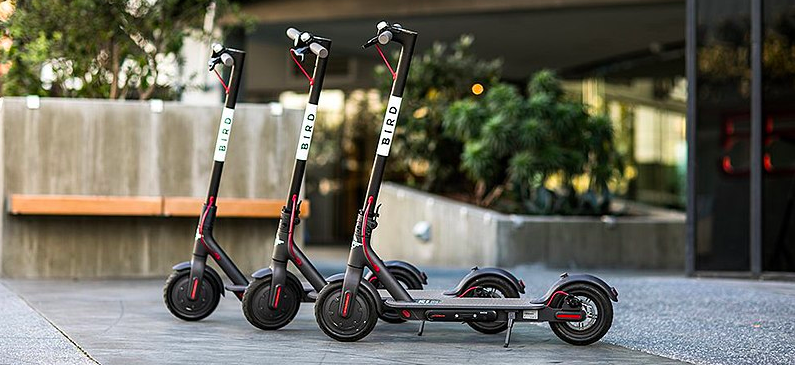In many American cities, residents are waking up to find that rentable dockless scooters and bikes have filled their city’s streets. The providers of shared electric scooters and bikes, companies like Bird, Lime, and Uber’s Jump, each aim to provide consumers with transportation alternatives to cars and motorcycles. These companies have created a new transportation industry called the micro-mobility industry, which refers to their platform’s comparatively small size. They each operate using a similar business model: After paying a base fee of around $1, consumers are charged per minute for their usage. Micro-mobility companies offer a transportation option that is both cheaper and more energy-efficient than cars. Moreover, in a time when our cities are clogged by traffic, scooters and bikes offer the potential to ease congestion on roads. However, due to concerns about the industry’s growth, user safety, and a lack of existing infrastructure, America’s cities have largely imposed burdensome regulations preventing the widespread adoption of dockless scooters and bikes. Instead, cities should shift their focus to reducing street congestion and pollution.
Los Angeles is one city that has taken extreme action to limit the spread of these companies. Beverly Hills, for example, outlawed dockless electric scooters, and West Hollywood has banned the parking of scooters within city limits. Beverly Hills officials described a “concern for public safety and a lack of any advanced planning and outreach by the motorized scooter companies” as the primary reasons to impose new regulations. But concerns for safety are overblown because scooters are no more dangerous than the cars they share the streets with. Cars pose a massive public health risk to both drivers and the public at large: Cars kill 40,000 each year in America alone, including 6,000 pedestrians. Only three e-scooter deaths have been reported and one of these deaths was caused by a collision with a car whose driver was on heroin. One study actually highlighted the potential for electric scooters to decrease transportation injuries: “With 34 percent of Portland scooter riders stating they replaced car trips with e-scooter trips, an increase in e-scooter use has the potential to contribute to a reduction in serious injuries and fatalities.” While cities are rightfully concerned by a lack of planning, this does not justify burdensome regulations which inhibit cities from reaping the benefits of shared scooters and bikes.
Los Angeles should instead shift its focus to maximizing the micro-mobility industry’s capacity to decrease congestion. The city’s traffic has been ranked as the worst in the world for six consecutive years, and alternative transportation offers part of the solution. As scooters and bikes are far more space-efficient than cars, shifting commuters to these options could dramatically decrease congestion by using roads in a more space efficient way. For those with longer commutes, micro-mobility platforms further public transportation’s ability to decrease congestion by increasing the reach of the city’s train and bus system. Electric bikes and scooters offer a “last mile” service to make the walk to a train station or bus stop possible or simply more convenient, which takes more people off the roads and furthers the city’s goal of decreasing congestion.
As scooters and bikes are far more space-efficient than cars, shifting commuters to these options could dramatically decrease congestion.
New York has banned electric scooters and bikes from as early as 2004, and this overly punitive policy has been driven in part by a lack of infrastructure for micro-mobility options. Dockless bike and scooter companies are barred from operating in the city’s most populated areas. The motivation for this ban is simple: “There’s no place for scooters, physically.” Scooters are too fast for the sidewalk, too slow for traffic, and dedicated bike lanes are sparse throughout most of New York City. The problem is not micro-mobility companies; it is the infrastructure. New York City “is designed for cars and only cars… almost every foot of curbside space [is dedicated] to long-term parking.” The city should allocate parking space for dockless scooters and bikes to facilitate their growth. Additionally, parking space ought to be converted to bike lanes so scooters and bikes can travel safely throughout the city.
New York City, in accepting the status quo where cars dominate the streets, has undermined electric scooters’ and bikes’ ability to decrease pollution. Motor vehicles are the single largest contributor to ground level smog, whose dire public health effects include permanent lung damage and increased asthma rates. The city has also pledged to reduce greenhouse gas emissions by 80 percent by 2050, yet officials have done little to curb the city’s reliance on cars. By shifting car riders to electric scooters and bikes, the city could greatly reduce the deleterious effects of pollution on the environment and public health. But it continues to treat cars as sacrosanct, failing to benefit from the services of micro-mobility companies.
Shared micro-mobility companies offer an innovative, space-efficient, and environmentally sustainable transportation alternative to cars. Rather than restricting their adoption, cities should regulate these companies with a pro-growth mindset to maximize the benefits of shared bikes and scooters. By working with, instead of against, micro-mobility companies, cities will be able to chart a course to achieve their environmental, public health, and traffic goals.
Photo: Bird Scooters
